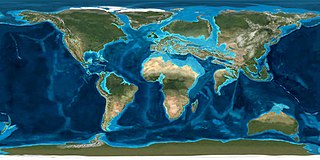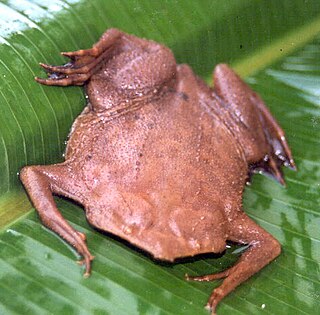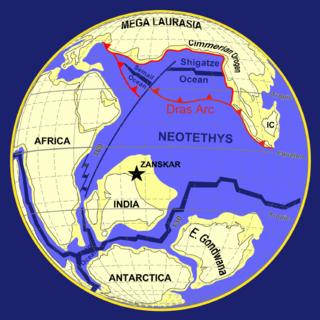
The Deccan Traps are a large igneous province of west-central India. They are one of the largest volcanic features on Earth, taking the form of a large shield volcano. They consist of many layers of solidified flood basalt that together are more than about 2,000 metres (6,600 ft) thick, cover an area of about 500,000 square kilometres (200,000 sq mi), and have a volume of about 1,000,000 cubic kilometres (200,000 cu mi). Originally, the Deccan Traps may have covered about 1,500,000 square kilometres (600,000 sq mi), with a correspondingly larger original volume. This volume overlies the Archean age Indian Shield, which is likely the lithology the province passed through during eruption. The province is commonly divided into four subprovinces: the main Deccan, the Malwa Plateau, the Mandla Lobe, and the Saurashtran Plateau.

The Paleogene Period is a geologic period and system that spans 43 million years from the end of the Cretaceous Period 66 Ma to the beginning of the Neogene Period 23.03 Ma. It is the first period of the Cenozoic Era, the tenth period of the Phanerozoic and is divided into the Paleocene, Eocene, and Oligocene epochs. The earlier term Tertiary Period was used to define the time now covered by the Paleogene Period and subsequent Neogene Period; despite no longer being recognized as a formal stratigraphic term, "Tertiary" still sometimes remains in informal use. Paleogene is often abbreviated "Pg", although the United States Geological Survey uses the abbreviation "Pe" for the Paleogene on the Survey's geologic maps.

Palmoxylon is an extinct genus of palm named from petrified wood found around the world.

Sooglossidae, the Seychelles frogs or Seychelles Island frogs, are a family of frogs found on the Seychelles Islands. Until recently, this family was believed to include the genera Sechellophryne, Nesomantis and Sooglossus, but following a major revision of amphibians in 2006, the genus Nesomantis was named a junior synonym of Sooglossus. Their closest relatives are the purple frogs (Nasikabatrachidae) of India.
The Danian is the oldest age or lowest stage of the Paleocene Epoch or Series, of the Paleogene Period or System, and of the Cenozoic Era or Erathem. The beginning of the Danian is at the Cretaceous–Paleogene extinction event 66 Ma. The age ended 61.6 Ma, being followed by the Selandian.

In the geologic timescale the Ypresian is the oldest age or lowest stratigraphic stage of the Eocene. It spans the time between 56 and47.8 Ma, is preceded by the Thanetian Age and is followed by the Eocene Lutetian Age. The Ypresian is consistent with the Lower Eocene.

Palaeobatrachus is an extinct genus of frogs from Europe that existed from the middle Eocene to the middle Pleistocene, spanning almost 50 million years. They were obligately aquatic, and would have not spent much time on dry land. They are one of two genera and by far the largest genus in the family Palaeobatrachidae, which are considered to be members of Pipimorpha, related to the South American-African family Pipidae, which includes the African clawed frog and Surinam toad.

Bothremydidae is an extinct family of side-necked turtles (Pleurodira) known from the Cretaceous and Cenozoic. They are closely related to Podocnemididae, and are amongst the most widely distributed pleurodire groups, with their fossils having been found in Africa, India, the Middle East, Europe, North America and South America. Bothremydids were aquatic turtles with a high morphological diversity, indicative of generalist, molluscivorous, piscivorous and possibly herbivorous grazing diets, with some probably capable of suction feeding. Unlike modern pleurodires, which are exclusively freshwater, bothremydids inhabited freshwater, marine and coastal environments. Their marine habits allowed bothremydids to disperse across oceanic barriers into Europe and North America during the early Late Cretaceous (Cenomanian). The youngest records of the group are indeterminate remains from Saudi Arabia and Oman, dating to the Miocene.

The Paleocene, or Palaeocene, is a geological epoch that lasted from about 66 to 56 million years ago (mya). It is the first epoch of the Paleogene Period in the modern Cenozoic Era. The name is a combination of the Ancient Greek παλαιός palaiós meaning "old" and the Eocene Epoch, translating to "the old part of the Eocene".

The Maastricht Formation, named after the city of Maastricht in the Netherlands, is a geological formation in the Netherlands and Belgium whose strata date back to the Late Cretaceous, within 500,000 years of the Cretaceous–Paleogene boundary, now dated at 66 million years ago. The formation is part of the Chalk Group and is between 30 and 90 metres thick. It crops out in southern parts of Dutch and Belgian Limburg and adjacent areas in Germany. It can be found in the subsurface of northern Belgium and southeastern Netherlands, especially in the Campine Basin and Roer Valley Graben. Dinosaur remains are among the fossils that have been recovered from the formation.
The Intertrappean Beds are a Late Cretaceous and early Paleogene geologic unit in India. These beds are found as interbeds between Deccan Traps layers, including the slightly older Lameta Formation. They consist a number of different subgroups and formations, and span the Cretaceous–Paleogene boundary.

Pipoidea are a clade of frogs, that contains the most recent common ancestor of living Pipidae and Rhinophrynidae as well as all its descendants. It is broadly equivalent to Xenoanura.
Deccanolestes is a scansorial, basal Euarchontan from the Late Cretaceous (Maastrichtian) and Paleocene Intertrappean Beds of Andhra Pradesh, India. It may be closely related to Sahnitherium. Deccanolestes has been referred to Palaeoryctidae in the past, but recent evidence has shown that it is either the most basal Euarchontan, as the earliest known Adapisoriculid, or as a stem-afrotherian.

Insular India was an isolated landmass which became the Indian subcontinent. Across the latter stages of the Cretaceous and most of the Paleocene, following the breakup of Gondwana, the Indian subcontinent remained an isolated landmass as the Indian Plate drifted across the Tethys Ocean, forming the Indian Ocean. The process of India's separation from Madagascar first began 88 million years ago, but complete isolation only occurred towards the end of the Maastrichtian, a process that has been suggested to be the creation of the Deccan Traps. Soon after, the land mass moved northward rather quickly, until contact with Asia was established 55 million years ago. Even then, both landmasses did not become fully united until around 35 million years ago, and periods of isolation occurred as recently as 24 million years ago.

Sunil Bajpai is the Chair Professor of Vertebrate Paleontology in the Department of Earth Sciences, Indian Institute of Technology Roorkee. He is in service as a professor at IIT Roorkee since 1st January 1996 till 30 September 2026. He also served as the director of the Birbal Sahni Institute of Palaeosciences from January 2013 to July 2018.

Sooglossoidea is a superfamily of frogs. It contains only two highly divergent families consisting of three genera with two species each, one family being found in southwestern India and the other in the Seychelles.

The Salamanca Formation is a geologic formation in the Golfo San Jorge Basin of central Patagonia that yields well-preserved, well-dated fossils from the early Paleocene. Studies of these fossils are providing new data on plant and animal diversity following the end-Cretaceous extinction event.
A hyperthermal event corresponds to a sudden warming of the planet on a geologic time scale.

Eekaulostomus is an extinct genus of marine fish from the Paleocene of Chiapas, Mexico. It contains one species, E. cuevasae, and is the only member of the family Eekaulostomidae.
Horaclupea is an extinct genus of freshwater and estuarine ray-finned fish that inhabited the Indian subcontinent from the latest Cretaceous to the early Eocene. It was a clupeid, making it related to modern herrings and anchovies. It was named after Indian ichthyologist Sunder Lal Hora, who described the first species of the genus.















